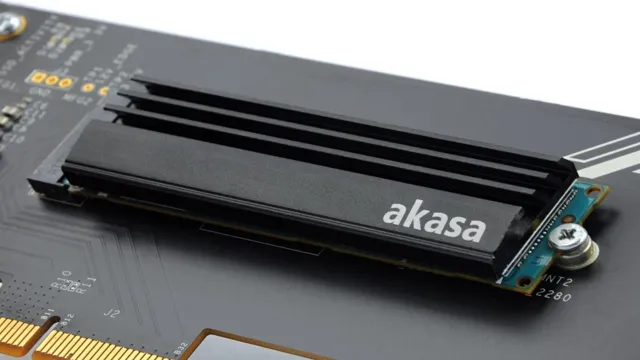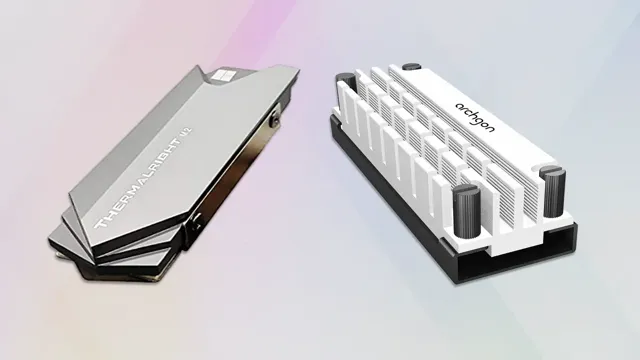When it comes to building a PC, one question that often arises is whether or not SSDs need heatsinks. While some argue that adding a heatsink can help dissipate heat and improve performance, others claim that it’s unnecessary and simply a matter of aesthetics. So, do SSDs really need heatsinks? Let’s delve deeper into this topic and find out.
What is an SSD?
If you’re building or upgrading a PC, you might be wondering whether an SSD needs a heatsink. The short answer is that it depends on the SSD and your usage. Some high-performance SSDs generate a lot of heat, which can cause thermal throttling and reduce overall performance.
In this case, adding a heatsink can help dissipate the heat and keep the SSD running at peak speeds. However, most consumer-grade SSDs don’t require a heatsink, especially if you’re using them for basic tasks like browsing the web or running productivity apps. If you’re a gamer or enthusiast who’s pushing your system to the limit, it’s worth considering a heatsink or other cooling solution for your SSD.
Ultimately, it’s all about striking a balance between performance and temperature, so you can enjoy lightning-fast speeds without overheating your system.
Definition and Overview
An SSD, or Solid State Drive, is a type of storage device that uses flash memory to store data. Unlike traditional hard disk drives (HDDs), SSDs have no moving parts and instead rely on interconnected flash memory chips to store and retrieve data. This results in faster read and write speeds, as well as greater efficiency, as SSDs require less power and generate less heat than HDDs.
SSDs are becoming increasingly popular in consumer electronics such as laptops, tablets, and smartphones, as well as in enterprise-level storage systems where speed and reliability are critical. Overall, an SSD is a powerful and efficient storage solution that offers a significant performance boost compared to traditional HDDs.

The Role of Heat in SSDs
If you’re a tech enthusiast, you might have come across discussions about adding heatsinks to solid-state drives (SSDs) to improve their performance and lifespan. So, the question remains, do SSDs need heatsinks? Well, the short answer is no. Unlike traditional hard disk drives (HDDs), SSDs have no moving parts; hence they don’t generate heat in the same way as HDDs.
However, that doesn’t mean that SSDs don’t generate heat at all. They do, and it can cause overheating if they’re not properly cooled. This is especially true for high-speed, high-performance SSDs that are used for gaming, video rendering, or other heavy applications, where the drive can get extremely hot.
In such situations, adding a heatsink to your SSD can help to dissipate the heat, preventing the drive from becoming too hot and potentially damaging performance. But if you’re using a standard SSD for general purposes like surfing the web or running office apps, adding a heatsink is unnecessary. Overall, while SSDs don’t require heatsinks as a general rule, adding one is beneficial if you’re pushing the drive to the limit with intensive tasks.
How Heat Affects SSD Performance
Heat can have a significant impact on the performance of solid-state drives (SSDs). When SSDs get too hot, they can experience thermal throttling, which reduces their performance and can even lead to device failure. The operating temperature of an SSD is typically between 0 and 70 degrees Celsius, but if it exceeds this range, it can cause problems.
This can be particularly problematic in high-performance environments, such as gaming computers or data centers. In these situations, it’s important to ensure that the SSD is properly cooled and that airflow is optimized. It’s also worth noting that higher-capacity SSDs tend to generate more heat than their lower-capacity counterparts.
Overall, heat management is an important consideration for anyone using an SSD, as it can have a noticeable impact on the performance and lifespan of the drive.
Factors that Contribute to Heat Buildup
The role of heat in SSDs is an important factor that should not be ignored. Heat buildup can occur due to several factors, such as heavy workloads, insufficient airflow, and inadequate cooling systems. When SSDs generate heat, performance can take a hit, resulting in slower overall speeds and even potential data loss.
The heat generated can also have long-term effects on the SSD, reducing its lifespan and making it more prone to failures. It’s crucial to keep in mind that SSDs are more sensitive to temperature changes than traditional hard drives, and as such, proper cooling and ventilation are essential to maintaining their performance. By implementing adequate cooling systems and regularly monitoring temperatures, users can ensure that their SSDs will perform optimally and have a longer lifespan.
In the end, taking care of the heat buildup in SSDs can make a significant difference in the stability and longevity of these essential storage devices.
Benefits of Adding a Heatsink to Your SSD
If you are wondering if SSDs need a heatsink, the answer is that it depends on your usage. If you are someone who enjoys intense gaming sessions, or regularly performs high-intensity work on your computer, then a heatsink would definitely benefit your SSD. Adding a heatsink can help dissipate the heat generated by your SSD during these demanding activities, which can prolong the lifespan of your drive and prevent performance issues.
Additionally, a heatsink can improve the overall performance of your SSD by reducing the risk of throttling. So, while SSDs don’t necessarily require heatsinks, they can certainly benefit from them in certain situations. If you want to keep your SSD running at its best, it’s worth considering investing in a quality heatsink.
Increased Lifespan and Durability
Adding a heatsink to your SSD has multiple benefits, including increased lifespan and durability. SSDs generate heat during operation, which can cause performance issues and damage to the drive. By installing a heatsink onto your SSD, you can improve the cooling system and dissipate heat more efficiently, resulting in improved performance and durability.
The heatsink can also prevent thermal throttling, which occurs when the drive slows down to avoid overheating. Additionally, a cooler drive will use less power, resulting in longer battery life for laptops and mobile devices. Overall, adding a heatsink to your SSD is a simple and effective way to enhance its performance and extend its lifespan.
Improved Performance and Stability
Adding a heatsink to your SSD is a great way to boost the performance and stability of your computer. SSDs are incredibly fast and efficient, but they generate a lot of heat during operation. Over time, this heat can cause your SSD to slow down and even fail.
By adding a heatsink, you can dissipate this heat and keep your SSD running smoothly. A heatsink is a simple but effective solution that allows you to get the most out of your SSD. With a heatsink, you can enjoy improved read and write speeds, faster boot times, and more reliable performance overall.
So if you want to improve your computer’s performance and stability, consider adding a heatsink to your SSD. It’s a simple upgrade that can make a big difference!
When to Consider Adding a Heatsink
When it comes to SSDs, adding a heatsink is not always necessary, but there are certain situations when it may be beneficial. If you have a high-performance SSD that is constantly pushing its limits and running at a high temperature, adding a heatsink can improve its performance and stability. Additionally, if you plan on overclocking or pushing your hardware to its limits, a heatsink can help dissipate the heat and prevent damage to your SSD.
However, for most average users, a heatsink is not necessary and may even be more trouble than it’s worth. It’s important to consider your specific use case before deciding whether to invest in a heatsink for your SSD.
Factors to Consider
When deciding whether to add a heatsink to your electronic component, there are a few factors to consider. First and foremost, consider the thermal dissipation requirements of the component. If it generates a lot of heat, it will likely require a heatsink to prevent overheating and damage.
Additionally, think about the size and space constraints of your application. Heatsinks come in a variety of sizes and shapes, so finding one that fits within your design without obstructing other components can be a challenge. Additionally, consider the cost of adding a heatsink.
While cheaper, smaller components may not require a heatsink, larger, more expensive components may require the added expense to ensure longevity and performance. Overall, the decision to add a heatsink should be made carefully, taking into account the specific needs and constraints of your application.
Conclusion
In conclusion, do SSDs need a heatsink? Well, it depends on how hot they get and how much you stress them. If you’re a casual user, then you probably don’t need one. But, if you’re a power user and push your SSD to the limit, then a heatsink could be a valuable investment to keep it cool and prevent any potential damage.
In short, just like in life, it’s better to have a little extra protection, just in case.”
FAQs
Why do SSDs need a heatsink?
The high-speed operation of SSDs generates heat, and a heatsink helps dissipate that heat and prevent thermal throttling, thereby improving the performance and longevity of the drive.
Do all SSDs need a heatsink?
No, not all SSDs need a heatsink. Some high-end SSDs come with built-in heatsinks, while others may not require one due to lower operating temperatures or efficient heat dissipation mechanisms.
Can I add a heatsink to my existing SSD?
Yes, you can add a third-party heatsink to your existing SSD as long as it is compatible with your drive’s form factor and does not void your warranty. However, be sure to check if your SSD needs a heatsink before installing one.
What are the benefits of using a heatsink for SSDs?
Using a heatsink for SSDs can significantly improve their performance and lifespan by reducing the risk of thermal throttling, preventing data loss or corruption due to overheating, and maintaining the optimum temperature for sustained high-speed operation.

